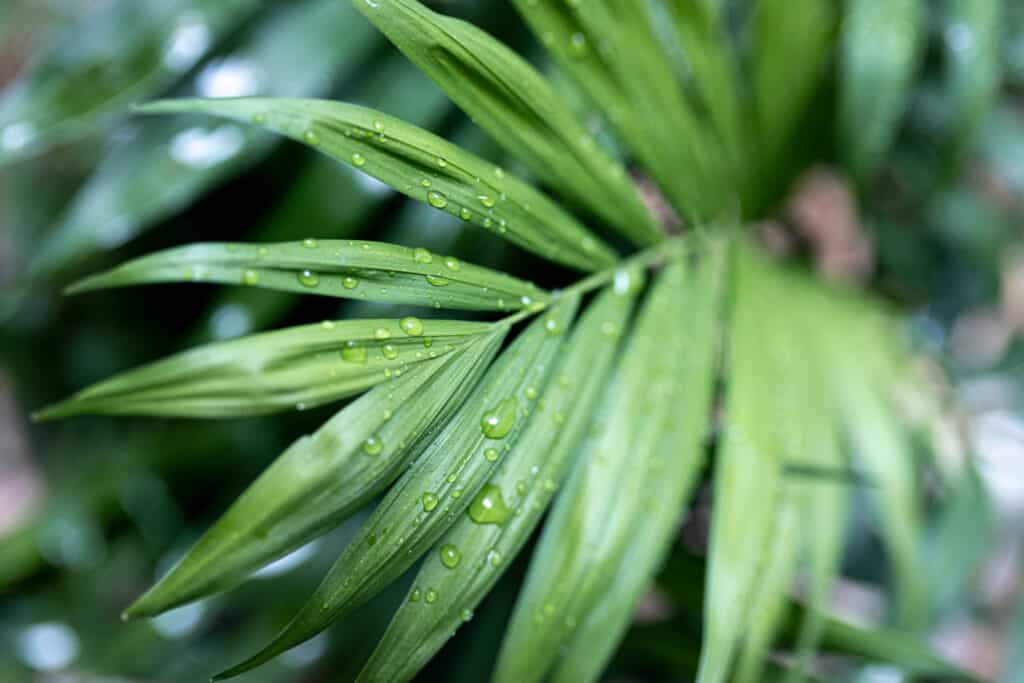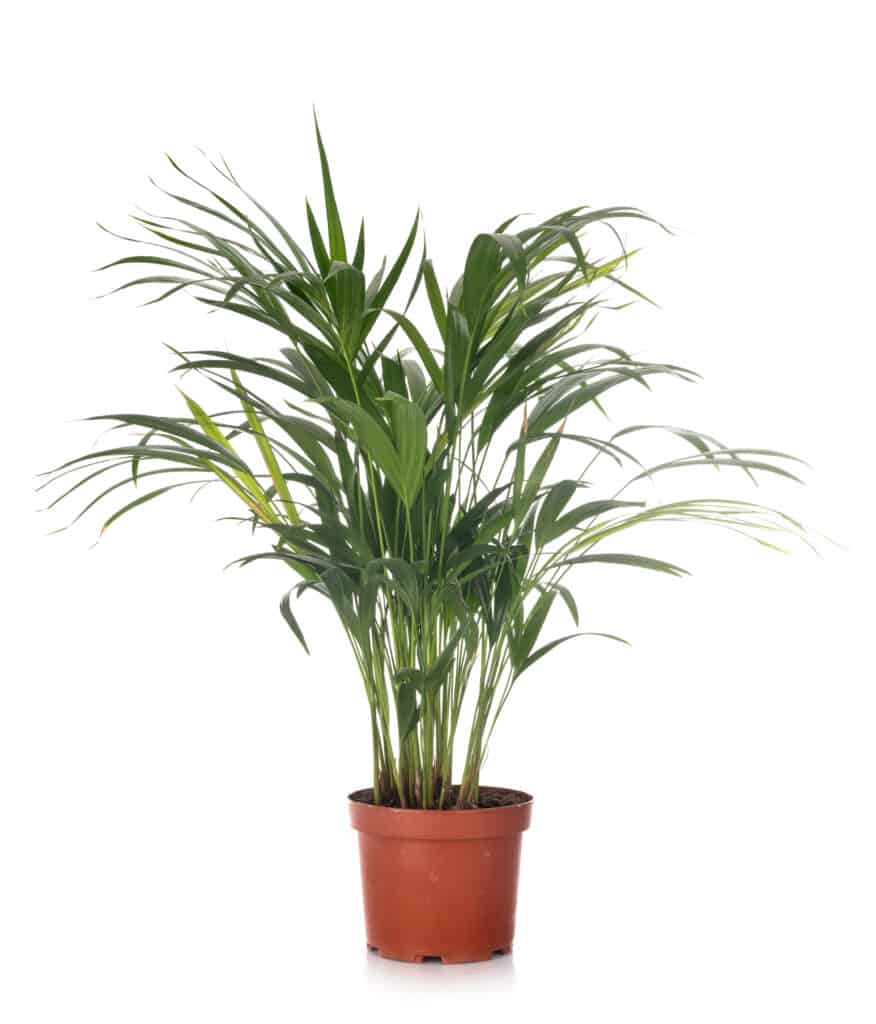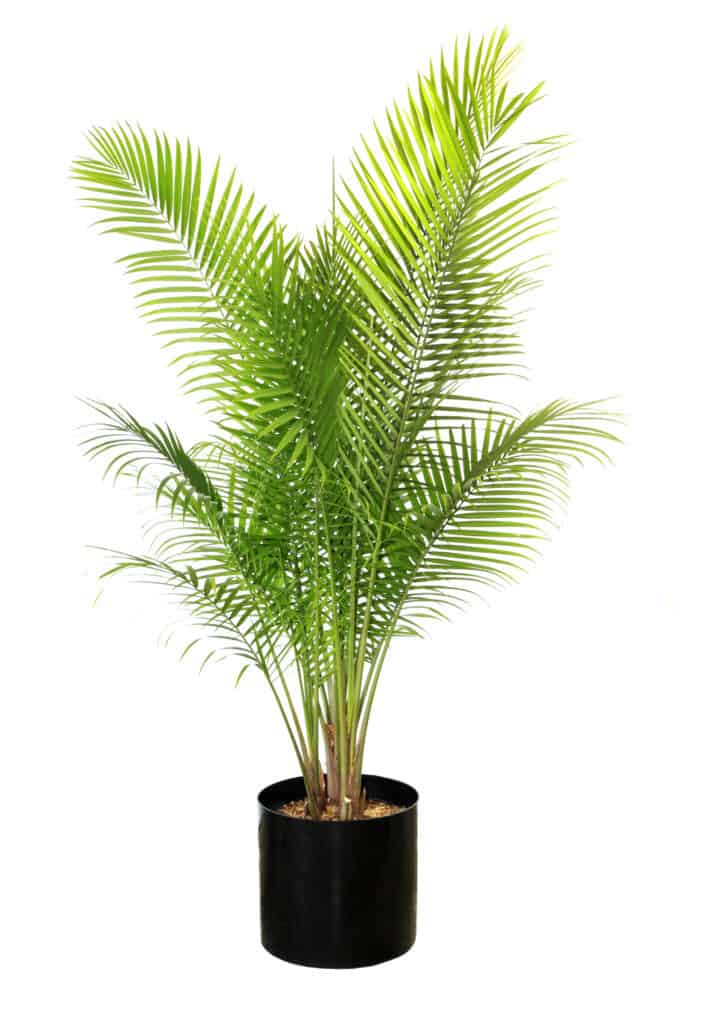Kentia palms and majesty palms are popular indoor plants that look similar at first glance. However, these two palm family members have vastly different temperaments and subtle aesthetic differences. If you’re wondering which one is best for your indoor plant collection, you’re in luck. This article will dive into the similarities and differences between these two plants. Here’s everything you need to know about the majesty palm vs. kentia palm.

The kentia plant fronds grow in a fountain shape from singular green stems.
©Celeste Fibla Beltran/Shutterstock.com
Comparing Kentia Palm vs. Majesty Palm
| Kentia Palm | Majesty Palm | |
|---|---|---|
| Classification | Howea forsteriana | Ravenea rivularis |
| Alternative Names | Paradise Palm | Majestic Palm |
| Origin | Lord Howe Island, Australia | Madagascar, The Comoros Islands |
| Description | A slow-growing palm tree with sharp, fountaining fronds in its youth. The individual stems grow into a unified trunk, and fronds fan out with maturation. Can grow 10 feet tall inside and 100 feet tall outside. | A slow-growing palm tree with sharp, fountaining fronds in its youth. The individual stems grow into a unified trunk, and fronds fan out with maturation. It can grow 10 feet tall inside and 100 feet tall outside. |
| Uses | A beginner-friendly indoor plant due to its drought resistance and moderate light needs. | A challenging indoor plant due to humidity and light needs. Beautiful outdoors in USDA hardiness zones 10-11. |
| Growth Tips | Plant in acidic, sandy soil for drainage. Place in indirect sunlight away from windows and vents. Water when the top two inches of soil are dry and mist occasionally. | Plant in acidic, sandy soil for drainage. Thrives in bright light. Do not let the soil dry out between waterings. Mist often. |
| Interesting Features | One of the most popular indoor palm plants. While they only grow naturally on Lord Howe Island, Hawaii grows most of North America’s supply. | Increasingly rare in the wild, with all 20 species in the Ravenea genus seriously endangered. |
Kentia Palm vs. Majesty Palm: Key Differences
Kentia palms and majesty palms are quite similar in appearance, especially in their youth. However, there are key differences in their temperament and care requirements. Kentia palms are considered a much more accessible, easy indoor plant than majesty palms. Let’s explore some of the key differences in detail.
Classification
Kentia palms and majesty palms are both members of the Arecaceae family — the palm family. Kentia palms are a member of the Howea genus, named for their endemic origin, Lord Howe Island. Howea belmoreana, the sentry palm, is the only other member of this genus.
Majesty palms are a member of the Ravenea genus. The 20 palms in this genus are native to Madagascar and the Comoros Islands in Africa. Majesty palms are the only member of the Ravenea grown and cultivated for indoor use.
Kentia Palm vs. Majesty Palm: Origin
Lord Howe Island is a small island in the Tasman Sea, off the East coast of Australia. Kentia palm cultivation is the island’s major economic industry. This unique climate boasts tropical temperatures with cooler ocean currents, contributing to the plant’s hardiness.
Madagascar and the Comoros Islands are off the Southeast coast of Africa. This tropical maritime climate provides the sun and moisture needed for majesty palms to thrive. However, wild Ravenea palms are expected to be extinct by the end of the century due to deforestation and water pollution.

Kentia palm cultivation is a major part of the economy of Lord Howe Island.
©cynoclub/Shutterstock.com
Description
Majesty palms and kentia palms are similar, as most indoor majesty palms are young. The shape, sizing, and growth patterns are similar in youth. However, majesty palm leaves are slightly thinner and sharper than kentia palm leaves. The difference is apparent in mature outdoor kentia and majesty palms.
Kentia Palm vs. Majesty Palm: Uses
The kentia palm and majesty palm are both popular indoor plants. However, the kentia palm is a better option for indoor gardeners. The resilient nature of the kentia palm makes it easy to care for, whereas the majesty palm is high-maintenance.
The kentia palm can also be grown outdoors in USDA hardiness zones 9–11.

The majesty palm is a slow-growing palm tree with sharp, fountaining fronds in its youth. The individual stems grow into a unified trunk, and fronds fan out with maturation.
©Steve Bower/Shutterstock.com
Kentia Palm vs. Majesty Palm: Growth Tips
Both the kentia palm and majesty palm require well-draining, loamy soil when grown indoors. The majesty palm requires continuous hydration and misting. The kentia palm does well with the same treatment but won’t suffer if the soil starts to dry out. Place your majesty palm in a brightly lit window away from cold drafts. The kentia palm prefers indirect sunlight but won’t suffer in a bright area.
The approach to outdoor planting is slightly different. Majesty palms need a bit of shade from the direct, overhead sunlight. Plant this palm near taller trees to provide a break during the day; otherwise, the leaves will turn yellow and wither. Plant this tree at the bottom of a slope for continuous root moisture.
Kentia palms don’t do as well outside. They require a lot of shade throughout the day and well-draining soil. Plant kentia palms at the top of a slope for continuous drainage.
The photo featured at the top of this post is © Celeste Fibla Beltran/Shutterstock.com
Sources
- Journal of World Heritage Studies, Available here: https://core.ac.uk/download/pdf/87204368.pdf
- PLOS One, Available here: https://journals.plos.org/plosone/article?id=10.1371/journal.pone.0103684
Thank you for reading! Have some feedback for us? Contact the AZ Animals editorial team.






